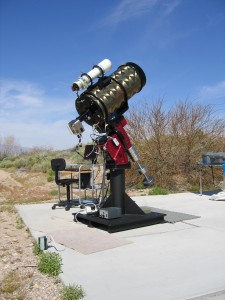Optics
 Optical Guidance Systems instruments are of the highest optical and mechanical quality possible. Skilled opticians using modern computer controlled polishing equipment manufacture our optics. Lightweight, conical mirrors are custom-made from near zero expansion ceramic, aluminized and silicon over-coated. Each system is diffraction limited, having a final wave error of 1/4 PV and 1/30 RMS. A Zygo interferogram with fringe analysis is provided to certify the optical quality of your telescope.
Optical Guidance Systems instruments are of the highest optical and mechanical quality possible. Skilled opticians using modern computer controlled polishing equipment manufacture our optics. Lightweight, conical mirrors are custom-made from near zero expansion ceramic, aluminized and silicon over-coated. Each system is diffraction limited, having a final wave error of 1/4 PV and 1/30 RMS. A Zygo interferogram with fringe analysis is provided to certify the optical quality of your telescope.
OGS Telescopes
Recognizing that no single optical design is best for all applications, OGS can supply Newtonian, Classical Cassegrain, Wright-Schmidt, Maksutov or Ritchey-Chretien systems configured to specifically meet your needs. Each instrument type has its own particular advantages and shortcomings. For lunar and planetary work, the large image scale produced by long focal length (f/10 and greater) Cassegrain telescopes is ideal; however, their restricted field of view limits their usefulness for observing extended deep-sky objects. Shorter focal length f/5 Newtonians and f/6.3 Schmidt-Cassegrains, with their wider fields, are more suitable for this class of object, but will suffer from inferior off-axis image quality, spherical aberration, and coma.
Where versatility is the key, OGS recommends the Ritchey-Chretien as it combines compact size, light weight and excellent on-and off-axis image quality in one design. It is the optical design chosen for nearly all of the new, state-of-the-art observatory telescopes, and is the same optical system as that used in the Hubble Space Telescope.
The following graphic shows spot diagrams of 1/2 degree off-axis star images produced by a 10″ f/8.5 Ritchey-Chretien, a 10″ f/10 Schmidt-Cassegrain, an f/5 Newtonian and an f/8 Classical Cassegrain. The superior image quality of the Ritchey-Chretien design is apparent.

The Ritchey-Chretien is coma-free, whereas the Schmidt-Cassegrain, Newtonian and Classical Cassegrain are not. The RC design utilizes hyperbolic primary and secondary mirrors which correct coma. The OGS Ritchey-Chretien system has a flatter field than production SC systems because of its lower secondary amplification factor, 2.9x versus 5x. The resultant lower f-number also provides the RC with a wider field and faster photographic speed.
Because the Ritchey-Chretien design has only two air-to-glass surfaces (compared to 4 for the SC) and no refracting elements, it has less light loss and a greater spectral range than the Schmidt-Cassegrain making the RC ideal for use with CCD cameras.
